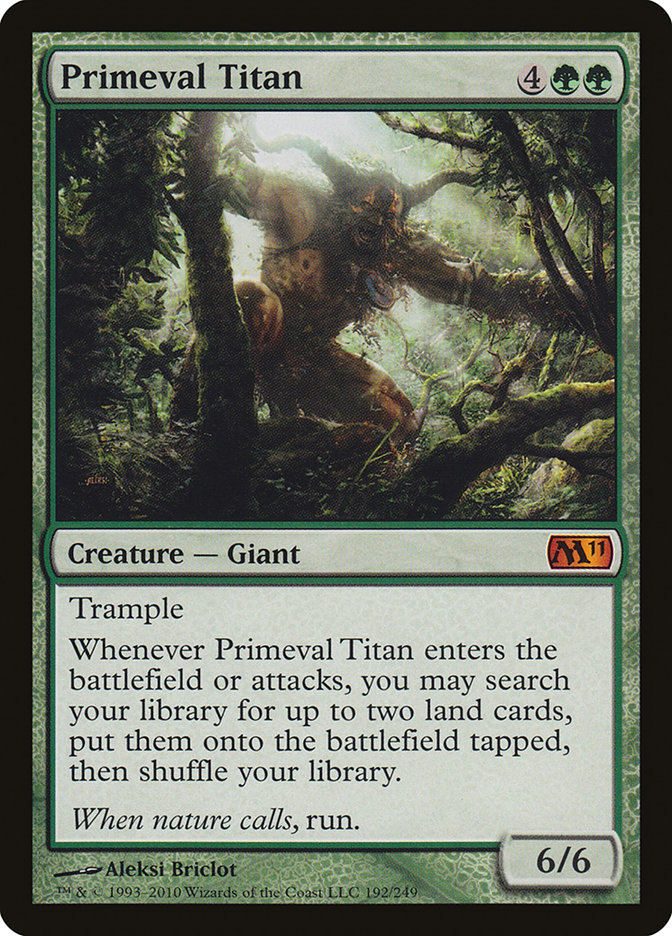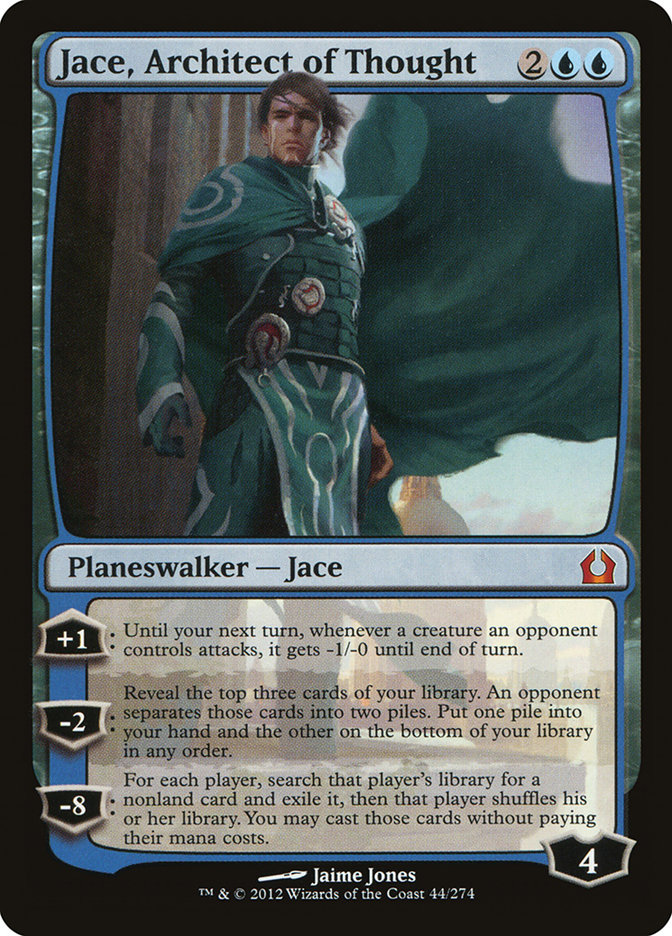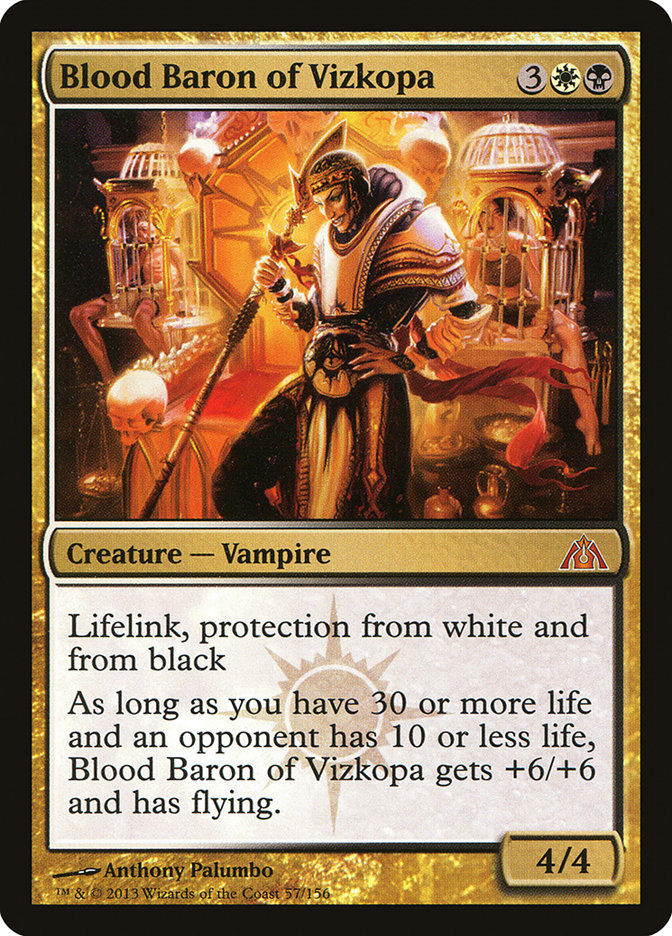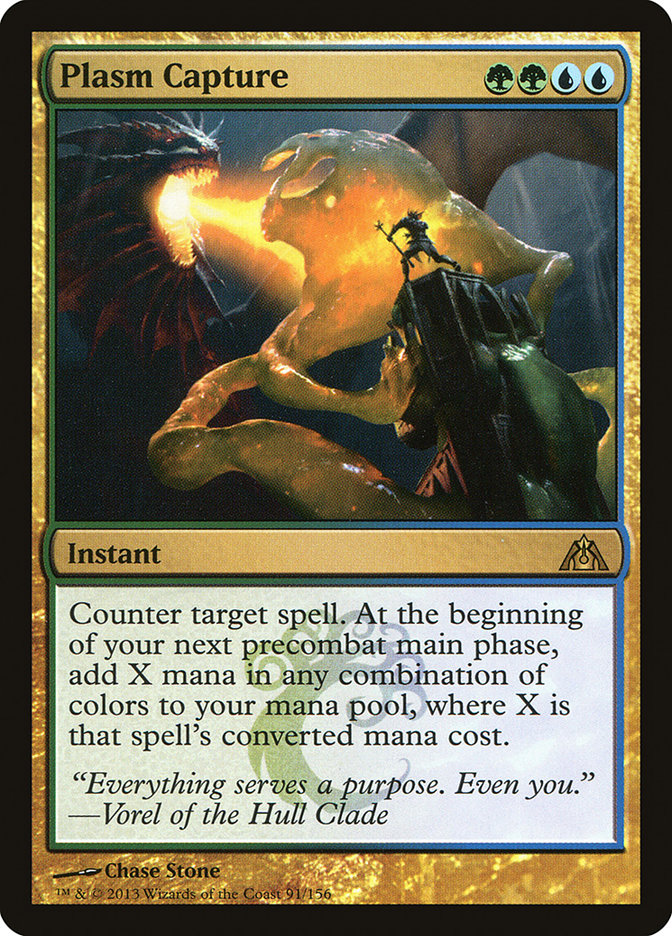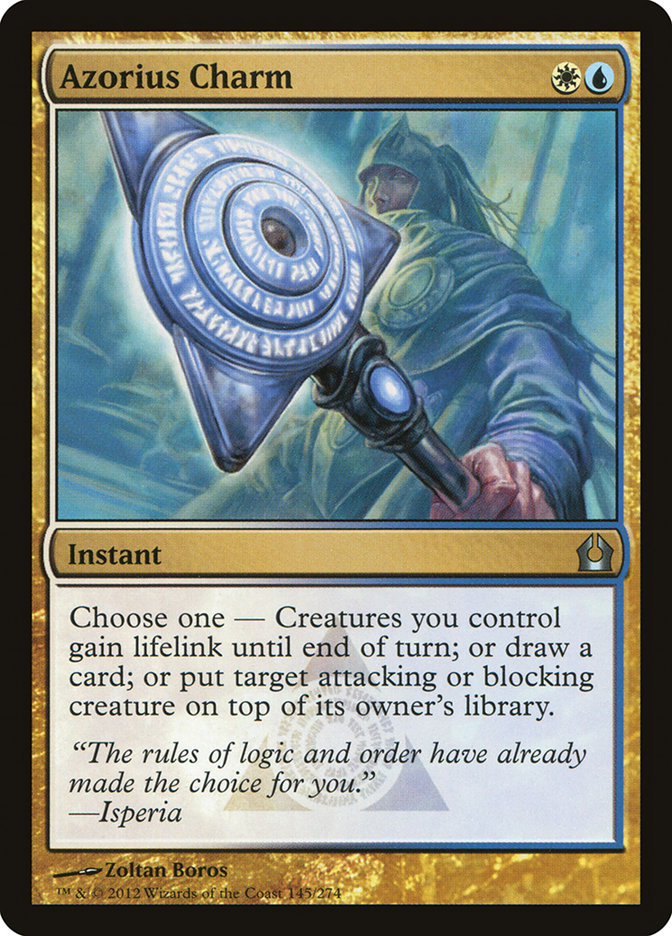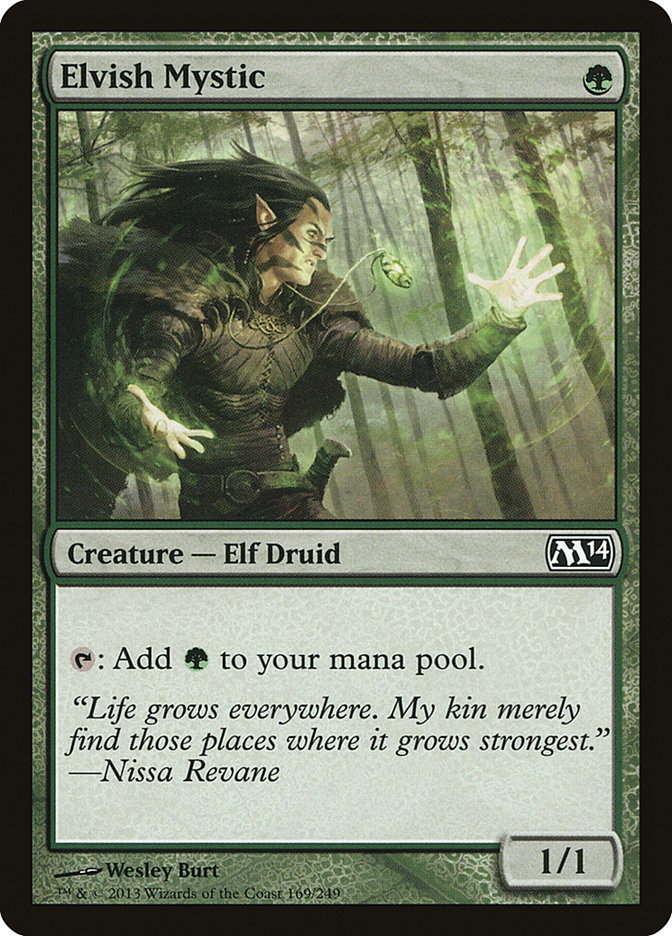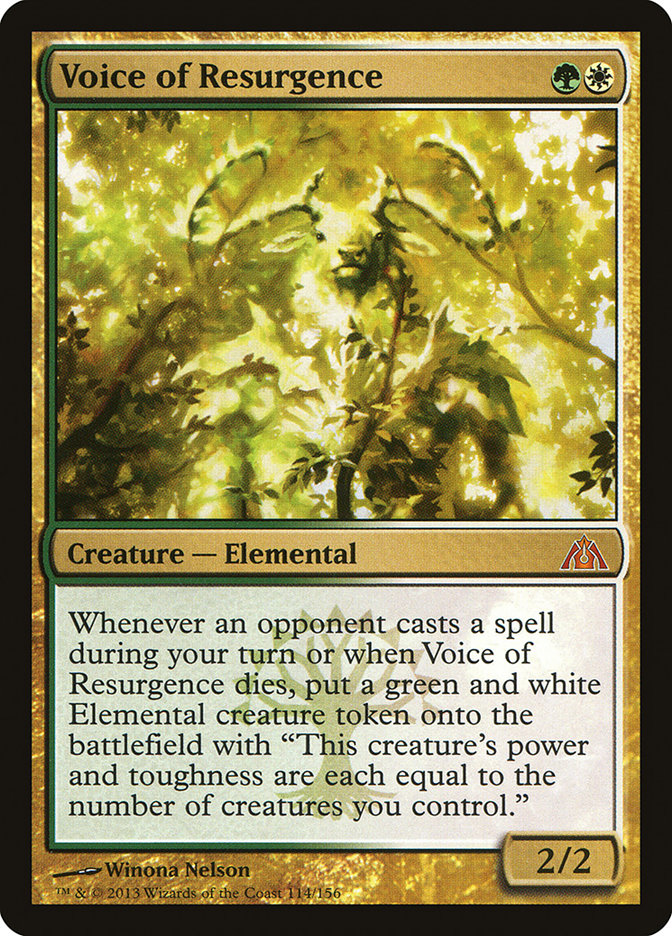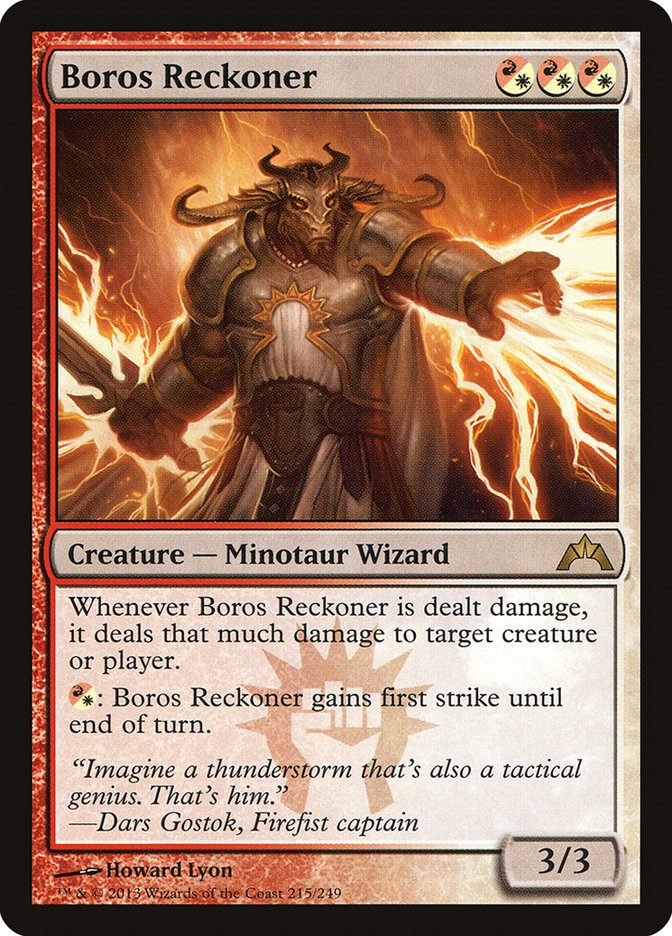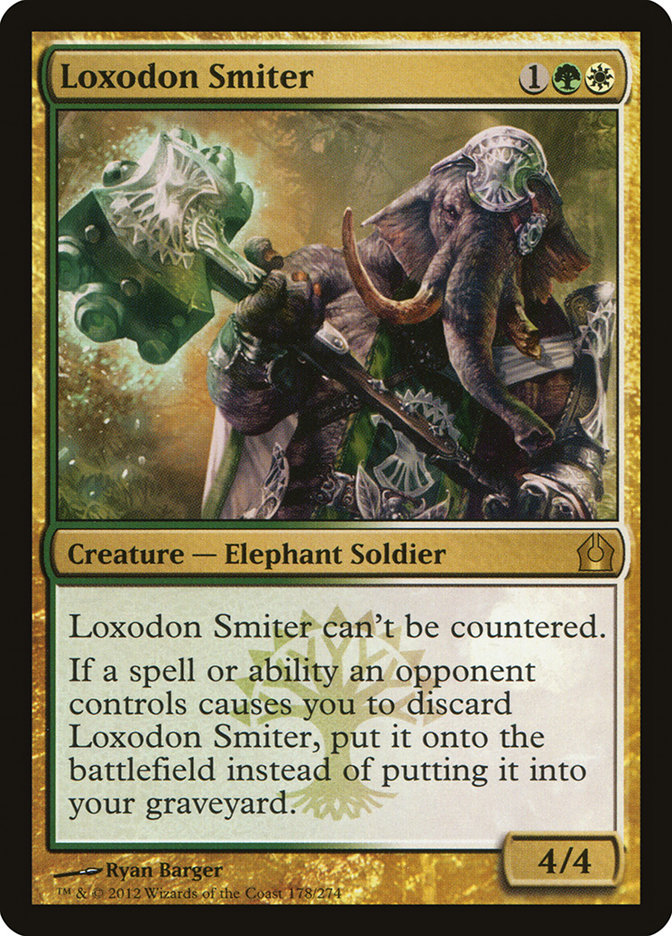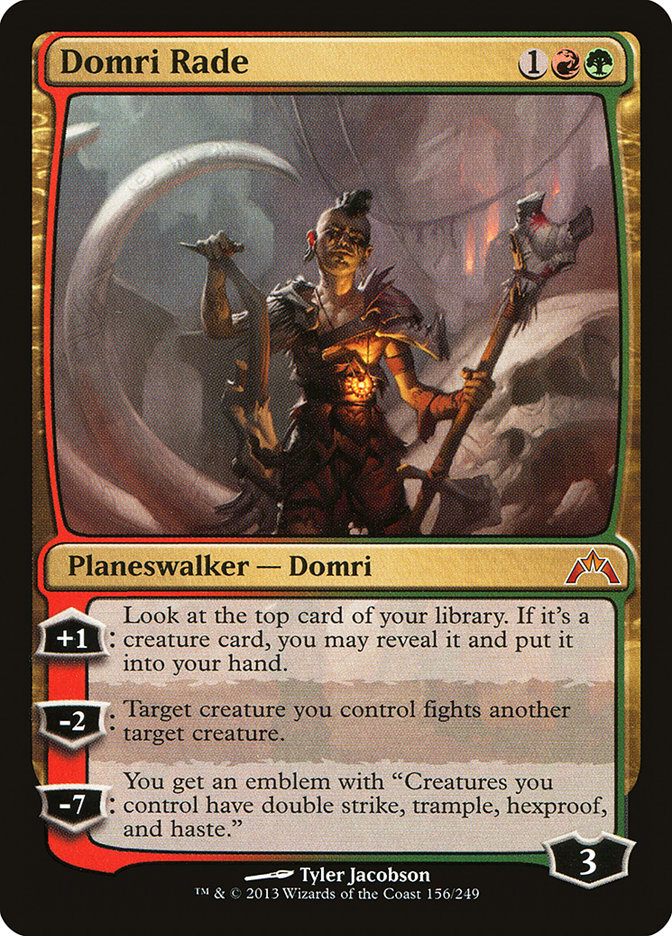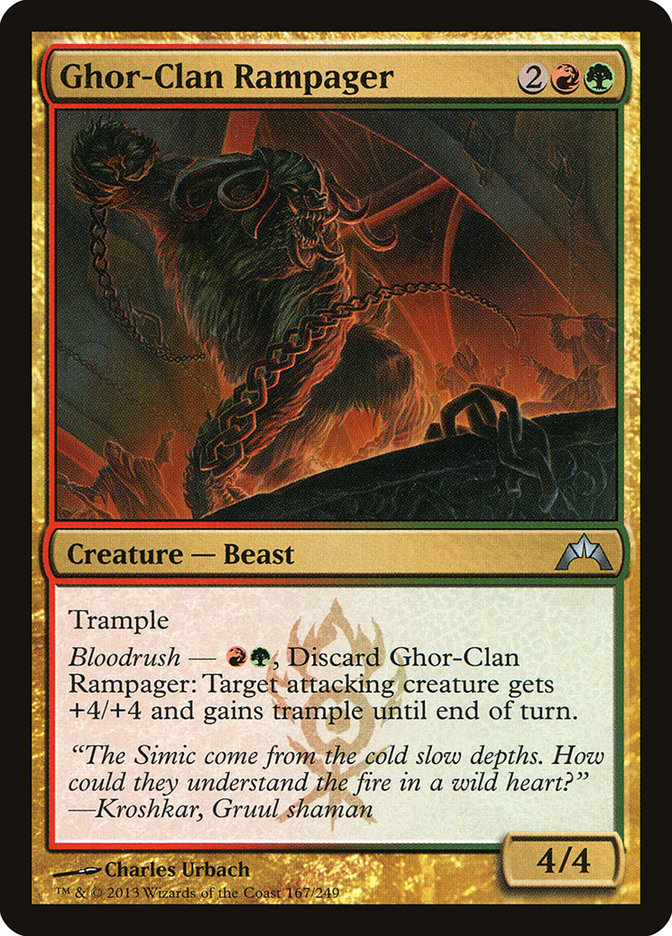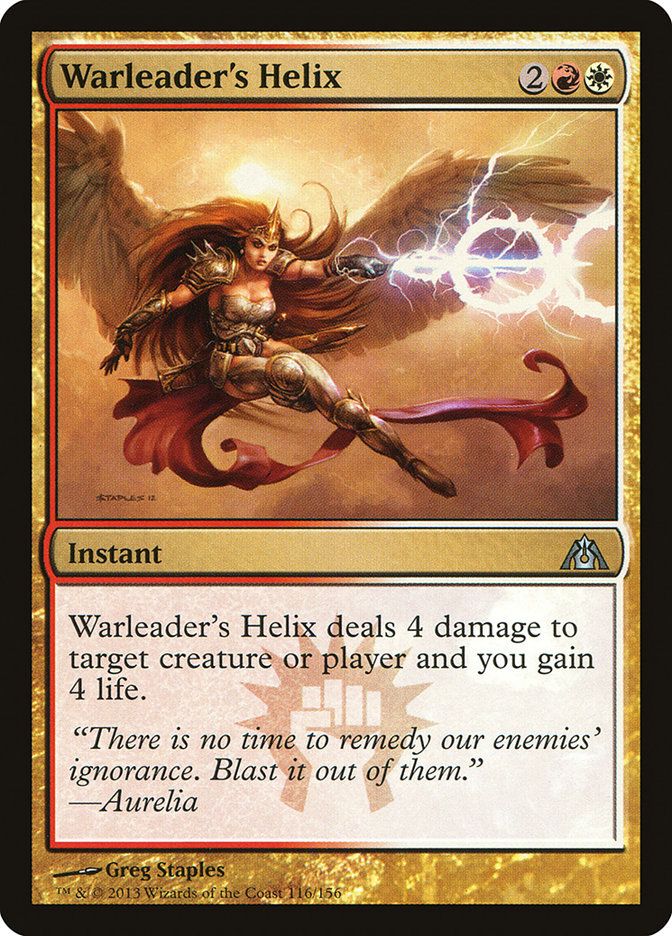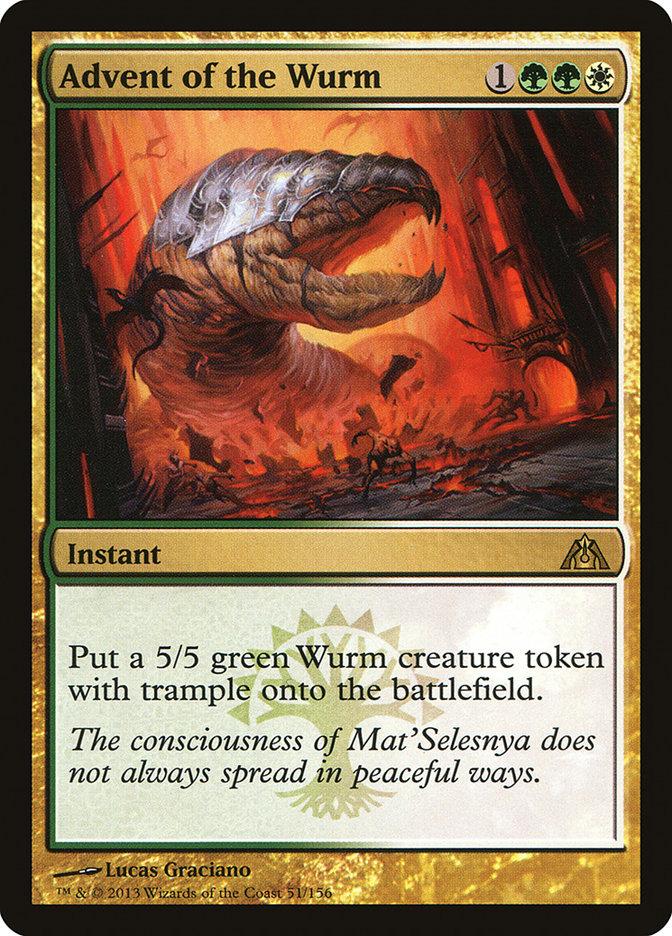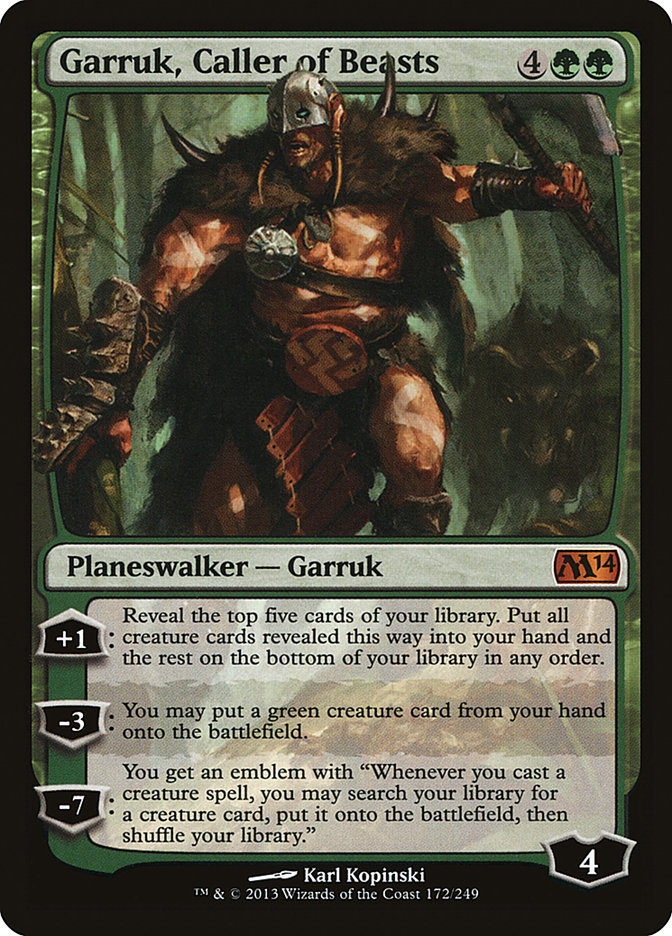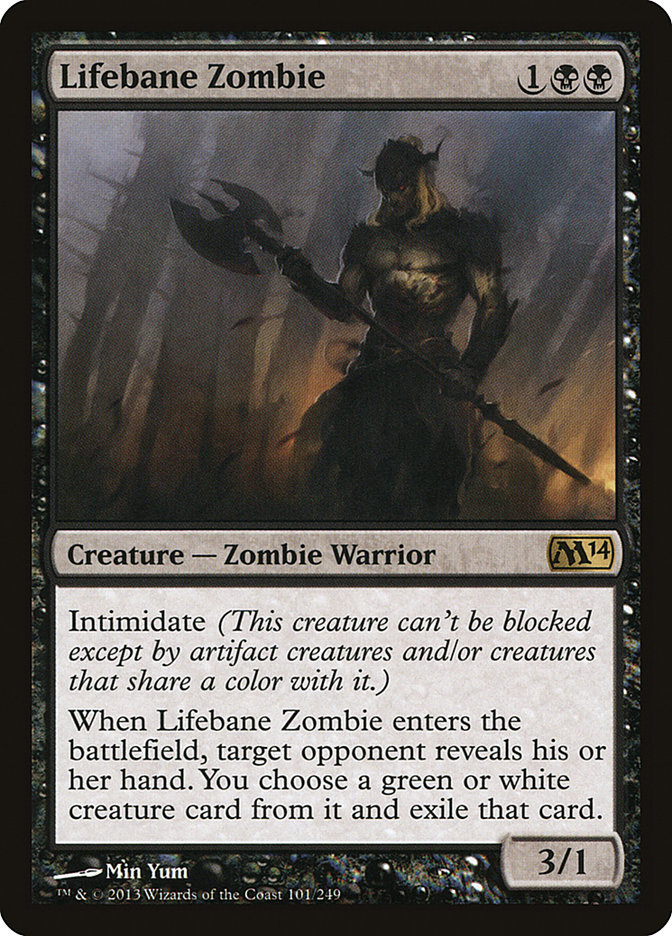G’day all!
After the past two weeks of Decoding Magic, I’m going to go back to talking about Standard this week. Well, sort of.
We have roughly a month before Theros is released and turns Standard on its head. I could sit here and talk about the Standard deck I played this past weekend in Baltimore, but what good is it when there are only a couple of Standard tournaments left?
Instead, I want to do a thought experiment of sorts. You see, I actually really enjoy looking into past data to try to predict future trends. I have an enormous Microsoft Excel spreadsheet saved on my computer at home with tons of self-produced algorithms to analyze past college football games in order to predict future outcomes (still working out some kinks in the Final Score algorithm(s)—coming to a Vegas bookie near you soon!). This is what I do in my free time; I absolutely love analyzing data.
There’s always a story in the numbers.
So I want to do that with Standard formats of years past. Today I’m going to start looking into what lists were predominant in Standard prior to the release of Return to Ravnica, Innistrad, and Scars of Mirrodin in order to determine what cards from previous blocks carried over to the new block. Were they the dominant Block deck of the previous format? Did they contain a specific pattern in terms of types of cards that dominated the new Standard format early (i.e., were streamlined aggro decks really predominant early)? Can we find any trends that may help us early on in Return to Ravnica / Theros Standard before the Theros preview season begins in earnest?
Also, I really like just looking back at what people were doing last year and seeing how much things have changed / stayed the same. Bear with me if you’re not of that same mindset.
Quick note: Dayv Doberne wrote about this last year, so I’m going to piggyback a bit off of his article (as it pertains to two years ago); it helps when someone has done the work for you!
Now, I know that virtually none of Theros has been spoiled as of yet, so this isn’t a “this is what you should play post-rotation” article; rather, I want to establish some rough guidelines for success in a format with the least amount of cards possibly available in a Standard format ever. These are times when deck complexity will be at an all-time low; not only are you short on possibilities for deck selection, but metagaming in formats like these is a shot in the dark at best. You’re best just sticking to a core strategy and jamming the most efficient spells that achieve that plan.
So let’s start at the beginning (Scar) because, well, I want to I guess. Thank god for the StarCityGames.com Open Series, which makes it really easy to go back in time in the coverage archive!
End of Shards of Alara / Zendikar Standard
Remember the days of Standard Bloodbraid Elf Jund? Mythic Conscription? Super Friends? The days when Standard had Jace, the Mind Sculptor and Stoneforge Mystic, yet people didn’t play them in every. Single. Deck?
Yep, that was the full power of Shards of Alara / Zendikar Standard. Step into my time machine for a second; let’s go back and explore those days.
Shards of Alara brought us the cascade mechanic, forever dooming the era of Lavalanche before it ever began; Bloodbraid Elf frustrated more than its fair share of players by “spinning the cascade roulette wheel.” Putrid Leech and Sprouting Thrinax held the fort until Bloodbraid Elf could start cascading into Blightning and Maelstrom Pulse, only to have Broodmate Dragon (later Inferno / Grave Titan) pick up the pieces. Sarkhan the Mad and Garruk Wildspeaker could append your main plan of “just cast Bloodbraid Elf and see what happens!” as well.
Creatures (18)
Planeswalkers (4)
Lands (26)
Spells (12)
Sideboard

That was until Zvi Mowshowitz (and company) figured out the total level of ridiculousness you could accomplish with the mana accelerants in Standard. (It almost feels like I’m not even talking about the past; “Jund is very good; Zvi uses a lot of fast accelerants to power out game winning spells early”. The more things change . . . )
Creatures (20)
Planeswalkers (7)
Lands (25)
Spells (8)
Sideboard

U/W/x Control existed in those days, just like in every format ever it seems. You had two flavors: standard U/W Control with Mind Spring and Martial Coup and the Super Friends list popularized by Lewis Laskin (and some guy named Ben Stark) that splashed red to play the full complement of Jace, the Mind Sculptor; Elspeth, Knight-Errant, and Ajani Vengeant. These cards were all in Standard together at one point; that’s insane if you think about their power level!
Vengevine Naya was also running around; the deck went through an evolution during its time in Standard, from Naya Lightsaber in the hands of Andre Coimbra to the Boss Naya deck that Luis Scott-Vargas went undefeated with in the Swiss rounds of Pro Tour San Diego. When Vengevine was released, people realized (again) that Bloodbraid Elf actually cast the second spell as well, so if the second spell was a creature, all the Vengevines were brought back from the grave. Fauna Shaman was the cream in the middle of that delicious Oreo that held the deck together.
There was also this little deck people were referring to as “Titan Ramp.” Ever since Zendikar was released, people had been trying to find ways to abuse Valakut, the Molten Pinnacle; initially, the ramp deck that made the best use of Valakut was a G/R Deck with Expedition Map (honestly, who thought that little artifact would get as much Constructed play as it has?!). There just wasn’t a better option to search up Valakut in Standard.
Until this giant:
Creatures (11)
Lands (28)
Spells (21)
- 2 Lightning Bolt
- 4 Rampant Growth
- 3 Harrow
- 4 Khalni Heart Expedition
- 2 Summoning Trap
- 2 Explore
- 4 Cultivate
Sideboard

There were other decks as well (Kalastria Highborn Vampires, Soul Sisters, Pyromancer’s Ascension), which only goes to demonstrate that the end of a Standard cycle offers enough diversity in card selection that you can play almost any strategy with some success.
Post-Scars of Mirrodin Release
The first tournament was won by a monocolored linear aggro deck. As straightforward as it gets:
Creatures (36)
- 4 Llanowar Elves
- 4 Elvish Archdruid
- 3 Nissa's Chosen
- 4 Arbor Elf
- 4 Joraga Warcaller
- 4 Joraga Treespeaker
- 4 Vengevine
- 4 Fauna Shaman
- 2 Sylvan Ranger
- 3 Ezuri, Renegade Leader
Planeswalkers (3)
Lands (18)
Spells (3)

Second place was taken down by a deck that was ubiquitous in the Block Pro Tour in San Juan, earning eventual winner Paulo Vitor Damo da Rosa a trip to the Top 8 (where his drafting skills helped him take down the event) and my favorite deck of all time: RUG Titan.
Creatures (11)
Planeswalkers (4)
Lands (27)
Spells (18)
Sideboard

Two weeks later, in Charlotte, Dan Jordan took down the Standard Open with RUG as well; in fact, half of the Top 8 was dominated by the Block deck turned Standard powerhouse. This was the beginning of the ushering in of that deck’s prominence early in the new metagame.
Second place was earned by a mono-red deck featuring Kuldotha Rebirth, marking the second event in a row that the top two slots were earned by a RUG deck straight from the Block Pro Tour and a monocolored aggro deck.
When you gaze further down the standings, you do see same variations (namely Simic Fauna Shaman and Pyromancer’s Ascension), but the most consistent performers so far were RUG Titan and linear decks.
What does this mean?
For starters, we see that the top deck from the Block Pro Tour starts out on top. Sure, there are some additions (TITANS!), but the core is essentially the most powerful things you could do in the previous block. Past that we see that other newer strategies in their infancy were better suited sticking to one or two colors and keeping it streamlined. While everyone remembers how sickening Valakut Ramp and Caw-Blade were from Zendikar / Scars Standard, that’s not how the format began (a clear example of recency bias). Decks weren’t finely tuned machines since they hadn’t had the time to coalesce; the exception is the “Block powerhouse” deck that was refined in Pro Tour testing done by pros and had the leg up on the less tuned non-linear strategies.
Lessons Learned #1
1. The Block Constructed deck with “all the good stuff” is a good choice at the beginning of the season.
2. Play powerful cards; don’t try to be cute
3. If you don’t want to play that deck and you only care about winning early, keep it simple and streamlined
4. The decks aren’t the tuned monstrosities they’ll eventually become. This is your time to start playing your preferred strategy so you can tune / test it out before the other decks become so tuned that they become oppressive.
This last point is the one that everyone seems to overlook; in the quest for instant gratification, people forget that the method to gain proficiency with their decks is to simply play them and learn them. Once decks become super-tuned innovation-suppressing machines, it becomes tough and incredibly frustrating to try to tune a new deck. This is a big reason why brewers lose interest in their brews later on in seasons since the Valakuts and Caw-Blades are already dominating. Instead of complaining about a format’s staleness late, try influencing it early on. You may create the next big thing!
End of Zendikar / Scars of Mirrodin Standard
This one’s a bit weird, and we all know why; after SCG Open Series: Baltimore in June 2011, Wizards decided to ban both Jace, the Mind Sculptor and Stoneforge Mystic. If not, the “end of season” decklists would look much different.
A taste of the pre-banning “metagame”:
Five of the Top 8 and eleven of the Top 16 decks had “Blade” in the name somewhere (a play on “Caw-Blade”), including the newly prominent Twin-Blade deck that combined not only the raw power of Caw-Blade but also the game-ending Deceiver Exarch / Splinter Twin combo. Ali Aintrazi hates playing the “best deck” but when he does, he tends to do well:
Creatures (10)
Planeswalkers (4)
Lands (18)
Spells (28)
- 3 Plains
- 3 Mountain
- 3 Island
- 2 Into the Roil
- 2 Spell Pierce
- 2 Dispel
- 3 Splinter Twin
- 4 Preordain
- 1 Sword of Feast and Famine
- 1 Batterskull
- 1 Sword of War and Peace
- 3 Dismember
Sideboard

I remember playing that deck during that tournament, and it was absurdly powerful on so many different levels. I’ve never played with a deck that powerful before or since. I think we can all agree that Wizards did something right when they went through with those bannings.
Back to the end of the season; with the “most powerful cards in Standard” being banned, the format was allowed to flourish a bit. Ali Aintrazi ended up winning Nationals with a U/B Control list that continued to show up all the way through the end of the season. Infect decks of many varieties were making the rounds, as were mono-red decks with the insanely powerful Shrine of Burning Rage.
Deceiver Twin combo decks existed, though they weren’t prominent near the end of the season. The Block “power” deck, Tempered Steel, was already showing up in pre-rotation results, and even remnants of Caw-Blade were placing as well. Other decks included the various Birthing Pod variants and the last remnants of Valakut players who hadn’t quite accepted that people realized how to beat them already. People also realized the power of combining Primeval Titan with lands other than Valakut (namely Inkmoth Nexus and Kessig Wolf Run), which made the deck less vulnerable to Tectonic Edge.
Again, we see that the end of the season was diverse and a great place to play almost anything you wanted (provided Wizards banned Jace and Stoneforge obviously).
Post-Innistrad Release
Initial results show that two-color decks were the way to go; from the U/B Control against U/R Delver matchup in the StarCityGames.com Standard Open in Las Vegas finals to the U/W decks running around, people stuck to two colors early on. A big thing you notice if you check out those lists is the complete lack of Geist of Saint Traft in the U/W lists. Again, people aren’t going to have the optimal builds early on in the season!
The format started coalescing a bit when people realized how good cheap blue creatures backed by the cheap disruption available really were. What started out as the “Illusions deck” with Lord of the Unreal would eventually morph to become the hated U/W Delver lists with Delver of Secrets and Geist of Saint Traft that dominated the majority of this season. The Innistrad value lands (Gavony Township, Nephalia Drownyard, Moorland Haunt, etc.) had a huge impact early, as most decks followed the color scheme of at least one of these lands in order to take advantage of their power level.
You also see a number of Primeval Titan deck variants; the World Championship was won by a Wolf Run Ramp deck featuring both Primeval Titan and Inferno Titan. There were innovations early on, but this was the majority of the “decks to worry about.”
Lessons Learned #2
1. Keep it simple; two colors at the most early on. No matter what strategy you pick, try to streamline it as much as possible, including the mana base, especially if the best lands available provide motivation to stay within two colors.
2. People don’t realize the full potential of cards early on; don’t listen to what everyone else says if you believe something is powerful. Remember, until Patrick Chapin played Olivia Voldaren at Worlds, most everyone believed it was a mediocre card.
3. While looking at the Pro Tour results is helpful when determining early deck choices, it isn’t law; the Pro Tour Top 8 featured multiple Tempered Steel and Puresteel Paladin decks, none of which showed up early. This is for various reasons, one of which was the terrible mana fixing in Scars block and the oppressive power that Tempered Steel had in that Pro Tour. There wasn’t an “all the good stuff” deck to play post-rotation.
End of Scars of Mirrodin / Innistrad Standard
The last event of note before the rotation of Scars of Mirrodin block and the core set was the StarCityGames.com Invitational in Atlanta won by Todd Anderson with, you guessed it, U/W Delver:
Creatures (15)
Lands (11)
Spells (34)
- 1 Plains
- 8 Island
- 2 Mana Leak
- 4 Ponder
- 3 Mental Misstep
- 4 Gitaxian Probe
- 4 Vapor Snag
- 4 Gut Shot
- 3 Spectral Flight
- 1 Thought Scour
Sideboard

(The Top 8 was Legacy, but Todd was carried in Standard by the Insect dude.)
This pretty much sums up the majority of the end times for Scars / Innistrad Standard.
Sure, there were other things you could be doing, but could it really beat “the new Faeries / Caw-Blade?” Most couldn’t answer affirmatively, so we were left with the Azorius Insectile Spirit Snapcaster deck as the deck to beat.
This was not a format defined by diversity.
The only other viable options were the brain-eating legions of B/R Zombies and the occasional Birthing Pod decks. Esper Control variants with Unburial Rites were present in addition to the last remnants of Primeval Titan ramp, but let’s be real here.
It was Delver’s world; we were all just living in it.
Post-Return to Ravnica Release
With the rotation of the Titans and the cheap spells that made Delver such a powerhouse, people could finally play midrange decks again. And play them they did!
The first tournament was actually won by a version of the deck that won the Block Pro Tour, Miracles. Todd Anderson definitely worked out the kinks by updating the deck, but you could see the power of miracles present in his winning list.
Behind that list, you start seeing the midrange decks that people could play. Jund Midrange, the “good stuff” deck from the previous block, got a huge boost from Thragtusk’s addition. In fact, if you look at the decklist early on and compare it to now, the deck has mostly remained the same: just jam the best stuff on-color and call it a day.
Farseek and the plethora of mana fixing changed the “stick to two color” equation a bit; the second place list was actually a Four-Color Reanimator list with Unburial Rites.
Going into the first post-Return to Ravnica Standard event, all the talk was about Zombies. B/R, B/G, Jund—everyone was worried about the brain eaters. It turned out that Zombies have trouble with both Pillar of Flame and Thragtusk. The “reign of Zombies” never came to pass, though people set up their decks for weeks as if it had.
Since mana bases weren’t an actual concern, people were free to simply play the most powerful things in their decks. Usually, streamlined decks are most potent early on; however, people at this stage last year were able to jam the most powerful things in a color combination and stitch is all together with Farseeks / shocklands / Innistrad enemy buddy lands. You do see some streamlined decks (G/W, B/R Zombies, etc.), but the rotation of the Titans in addition to the ease with which people could build their mana bases led the format down the path to midrange.
At different points throughout this Standard season, some midrangey deck has ruled the roost as the “best deck.” Even the U/W/x “Flash” decks tended to move more towards the midrange style. U/W/R, Jund, Junk Reanimator, Human Reanimator (for like one or two weeks), Naya, G/R Aggro, Prime Speaker Bant, B/G Midrange—it’s been the year of Thragtusk.
While the format is diverse now—and it really is in spite of everyone’s hatred of Jund—I think we’re all ready to move past the Thragtusk days, if for no other reason other than a shift in deck choices.
Lessons Learned #3
1. When you have Farseek / shocklands, throw everything I said about keeping it simple out the window. When mana bases no longer incentivize you for sticking to less than three colors and, in fact, essentially reward you in card selection for doing so, forget the “two color” rule in these unique circumstances.
2. Again, the “good stuff” deck from the previous Block format is a decent place to start; both Jund and Miracles had early success.
3. When you’re the deck everyone’s worried about early (Zombies in this case), be wary of playing it early unless it’s incredibly powerful. Also, if you’re a deck that folds to some of the reactive cards people are playing because of a deck like Zombies, be wary of playing that deck early as well. Be proactive when determining what people will be prepared for as much as possible (in other words, read up on StarCityGames.com; we’ll keep you informed!)
4. Be cognizant of what the cards that are rotating were oppressive to; the Titans and cheap blue spells rotating opened up the door for midrange to flourish.
Post-Rotation Thoughts
Based on our lessons learned, we should:
1. Look at the “good stuff” deck from the previous Block Pro Tour.
2. Keep it relatively simple (no Farseek!) and streamlined based on what we currently know about the upcoming state of mana fixing.
3. Play powerful cards; no caveats, it’s really that simple.
4. Watch what’s rotating and see how that affects certain cards / strategies.
5. If you want to brew, now’s the time!
Let’s start with number one first and take a look back at Pro Tour Dragon’s Maze in San Diego, which was won by Craig Wescoe. In fact, let’s start with his deck specifically:
Creatures (20)
Lands (23)
Spells (17)

I would say that this deck fits a couple of our “rules.” First, it’s streamlined and two colors. This is a big deal at the beginning of a new format, as we’ve already noticed, since we know mana bases are going to have to come down to earth a bit. It was obviously a powerful Block deck, winning the Pro Tour and all, though I’d back off a bit when we start talking about the “good stuff” deck (I don’t think this is it). It also contains cards that current (rotating) Standard cards are holding back.
Namely Advent of the Wurm (and to a lesser extent Call of the Conclave).
When you have Restoration Angel available to any deck that could play Advent of the Wurm, it’s going to be a tough sell playing Advent over Resto. Additionally, with Jund in the limelight, it is going to be really tough to validate playing a relatively vanilla 5/5 for four, even at instant speed, that doesn’t gain value when entering the battlefield. Over the past year, the format has been dominated by high value creatures, and the Wurm token simply didn’t fit the bill.
Not to mention it couldn’t even win a fight with Thragtusk; the ‘tusk player still had a token left over.
Call of the Conclave just matched up so poorly with the threats that Standard had to offer; again, Thragtusk matched up so well against it. There may be a home for it post-rotation, though that is yet to be seen.
So what would I consider the “good stuff” deck of Block to be?
Anything playing Azorius cards or the Naya deck.
This is because I believe both the Bant and Esper decks played the most powerful cards in Block.
That last one you’re all going to be sick of real soon. Why, you ask?
Because control decks are about to be really good.
If you haven’t noticed, the value creatures are slowly dying away. Thragtusk, Huntmaster of the Fells, Strangleroot Geist, Doomed Traveler, Falkenrath Aristocrat, Thundermaw Hellkite, Lingering Souls . . . the list could easily go on and on. The best thing we have left is going to be Voice of Resurgence. Look at it; we’re going to have Kalonian Hydra, Boros Reckoner, Loxodon Smiter; for the most part, the “powerful” creatures are going to be answerable at a one-for-one level. This is completely different than the past year where you had to present answers at a strategic level instead of answering threats at a one-for-one pace.
What I mean is that you had to present something that answered a large swath of creatures and threats rather than trying to remove them individually. Restoration Angel did a good job, as did Thragtusk; they stopped multiple threats. Huntmaster was absolutely huge, as was Boros Reckoner. You couldn’t nickel and dime people; you had to throw a bigger haymaker than your opponent.
Now control decks can tone it down a bit. Look at this past year’s control decks and at what they have left; almost every good tool they had before they still have! Detention Sphere, Azorius Charm, Sphinx’s Revelation, Supreme Verdict, Aetherling, and even new tools like Celestial Flare.
People are going to tout the oft-repeated line about “present questions, not answers” in their articles to implore you to play aggro and not control since “you can’t predict all the threats.” However, look at last year; Todd Anderson took the control deck from the previous Block Pro Tour, which contained super powerful cards, and won the first Standard Open. I think the same thing is going to happen here. Think about it this way; U/W already has more than enough tools to build an incredibly strong deck in this format and some of the most potent threats in years are about to rotate. Not only that but they still get to assimilate whatever goodies Theros provides!
And they get to play Aetherling!
The reason Aetherling hasn’t already run away with the crown of “Standard’s best creature” is because it does everything well except stabilize the board by itself. Unfortunately, in Standard now opponents are able to amass an incredibly resilient board state such that almost tapping out for an Aetherling is going to be a death knell.
That won’t be the case in a month or so.
The other “good stuff” deck is going to be Naya; again, look at the Standard deck that already exists:
Among other things. Now let’s look at what the deck could use if cards like Hellrider and Thundermaw Hellkite didn’t exist:
The one thing that makes me a bit hesitant is this card:
However, I don’t think Lifebane Zombie will be “format warping” or defining; I think it’ll be a rotational thing similar to how Boros Reckoner is now. Sometimes it’ll be amazing, and then people will move away from green and white creatures and it’ll be poor. In those times, Naya will be great, and then the Zombie will return . . .
It’s the circle of life!
You can play most of this deck now actually; in fact, unless I got a wild hair and decided to win this past weekend, you probably didn’t notice that I played the Naya deck at #SCGBALT. Part of the reason was how powerful it is, but another reason is because I wanted to see how much I liked casting the cards that would survive rotation. If I can start getting in reps with the deck I plan on playing post-rotation now, I can get a leg up on the competition come rotation time!
Obviously this isn’t an all-encompassing guide to post-rotation deck selection; Theros will definitely have an impact on the card and deck choices people make. However, early on in the format if you’re looking to be successful, look to years past to see what worked initially; the answer isn’t always “play aggro!!!!” as some would have you believe.
Until next week, when I hope Theros preview season will start finally!
@mikemartinlfs on Twitter

